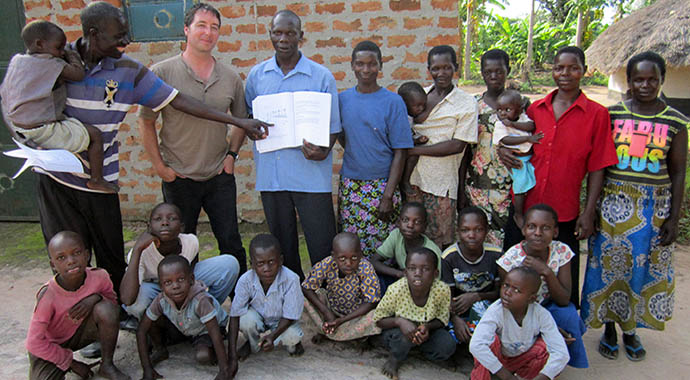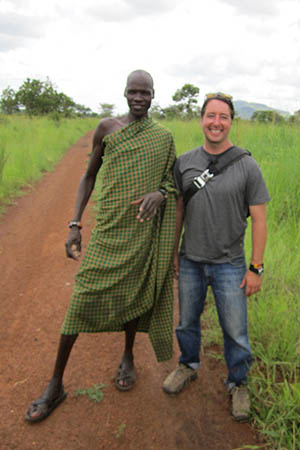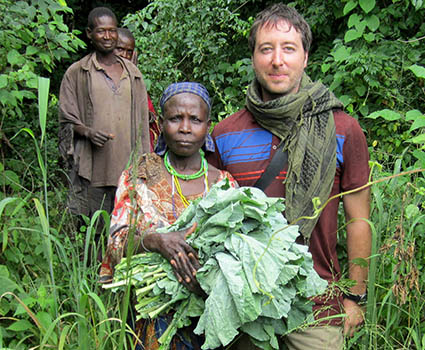Ogmius exchangeThe second article is by Drew Zackary, a Ph.D. student in cultural Anthropology at CU Boulder. Drew received an M.A. in Anthropology from UC Denver and a Bachelor of Sciences in Psychology from Colorado State University. Drew’s current interest is how climate change, livelihoods, conservation and culture interact at the local level. His Master’s thesis investigated ranching livelihoods outside of Yellowstone National Park after wolf re-introduction. Previously he has used sustainable livelihoods household assessment models to work in teams investigating agriculture in Ecuador. Drew is additionally interested in how human decision making is constrained by climate change and livelihood options are shaped by sociocultural contexts. One important component of applied scholarship is forging alliances across disciplinary boundaries. Currently, Drew is interested in how practitioners from national governments, non-profits and the natural sciences can work with cultural anthropologists on problem centered program design. Climate Change Adaptation: Early-Warning Forecasting in Northern Uganda - Summer 2014
|
This summer I was one of the Red Cross/ Red Crescent Climate Centre interns. I worked with the Partners for Resilience NGO consortium in Uganda building case studies on climate change resilience in rural communities and investigating the Early Warning Early Action forecasting system. Recently, NGOs have begun to focus on how to help communities adapt to future conditions that climate change will bring. By pre-emptively working development projects into the fabric of climate change forecasts and emergency preparedness the hope is to build more resilient communities. Rural communities are most vulnerable to disasters and livelihood insecurity. In Northern Uganda there will be an increase in flood risk as well as a shifting in the rain seasons.
The majority of people in northern Uganda are rain fed agriculturalists, pastoralists or a mixture of both. With little in the way of machinery, fertilizers or irrigation most farming families rely on traditional methods of cultivation and weather forecasting. As seasons shift, dry seasons lengthen and rainfall collects into smaller timeframes, leading to increased chances of waterlogging and floods. Partners for Resilience are working on tools to help local communities adapt and act in ways that can make their lives more resilient in the face of these climactic changes. One of those tools is the Early Warning/Early Action system.
One of my tasks this summer was investigating the ways in which PfR’s Early Warning/Early Action (EW/EA) system is being used by local communities to take disaster risk reducing actions to increase resilience. The PfR partners in each project area facilitate the EW/EA system. Basically, the philosophy behind EW/EA is to get reliable forecast information to local people, institutions, and aid structures before a disaster occurs, thus lowering the morbidity and mortality of these events. As the PfR partner Red Cross states in one of its guiding documents, EW/EA means; “Routinely taking humanitarian action before a disaster or health emergency happens, making full use of scientific information on all timescales.”
The PfR partners in both Otuke and Napak were using an EW/EA “matrix” to integrate traditional forecasting knowledge with scientific forecasts. The matrix is filled in during focus groups in the project communities. When the scientific forecast is given to communities, at 3-month intervals, the matrix is then used to discuss decisions and actions to be taken. Here is an example of the matrix being deployed:
Scientific Information |
Traditional Information |
Sector |
Possible Impact |
No-Regret Action |
Resources Required |
Responsible Person |
Wet season with increased rain |
Appearance of birds: Arum, Ibanga |
Agriculture |
Water logging of gardens, destruction of crops |
Establish water catchments, tarps for vegetables |
Funds, tauralpins, garden tools |
Households, community, NGO’s |
EW/EA Matrix for Amunga Parish-Olilim sub-county. 2012
Due to many different incidents and complications the dissemination of the forecasts to the communities I worked in all summer never occurred for that 3 month period. This was mainly due to the delay from the central Ugandan governmental ministries. At any rate, I was able then to find out how forecasting occurred and affected decision making during the 3 month period in the absence of PfR facilitation. I spent much of my time listening to people about what programs, such as goats or banana cuttings, were working best. I also continued to gather traditional categories of weather patterns and seasonal predictions.
My first stop was the remote village of Otuke in the Lango sub-region. Northern Uganda has a complicated and often tragic history. The people who live here in the Lango sub-region, mainly the Langi, have experienced marginalization and violence since the colonial era. Most recently the Lords Resistance Army led by Kony pushed people into IDP (Internally Displaced Persons) camps and destabilized the region for a generation. It is only since 2007 that this area has been secure. With multiple initiatives from the Ugandan government, World Bank, USAID, DFID (British government AID) and multiple NGOs, humanitarian development and governance work has shifted into high gear. The people who live in Otuke district are working hard at reclaiming traditional lands and developing infrastructure, effective governance, and resilient livelihoods. The Partners for Resilience project has worked very hard on developing hazard maps and early warning systems in the parishes of Otuke. (A parish is the smallest unit of governance in Uganda.)
The passing on of traditional knowledge of agricultural practices, forecasting and land boundaries combined with climate change aware practices and new knowledge about risk reduction is essential for producing resilient communities. It is here that resilience is more than a proxy for hope. The Langi of Otuke have been resilient in the face of near cultural elimination. The farmers ask, not for handouts, but as Langi farmer Peter Otim said to me, “We need more training, we need more knowledge.” Resilience is work, from the ground up.
The use of effective Early Warning/Early Action systems here is increasingly becoming a reality. PfR have facilitated the dissemination of quarterly (3 month) forecasts directly to the local people in Otuke and Irriri (Napak). In the past, officials rarely broadcast anything more than daily forecasts. PfR has worked with the meteorologist in Lira to take a Langi translated forecast to the district for dissemination. With this system trust is building. While many farmers said that they only used traditional forecasting, a few said that they used a combination of methods now that the information is given to them in a local language directly. In the coming year a new weather station in the district headquarters will be fully operational. There is hope that a streamlined system and newly hired technocrats will be able to get forecasts to farmers quickly before planting season’s start.
My second fieldsite was in Karamoja, in the Napak district. Here the ecosystem and socio-cultural contexts are very different from Otuke. The Karamojong are mainly pastoralists, with increasing numbers of agriculturalists and agro-pastoralists. The language and social structures differed widely from the Langi people. One thing remained certain, though: climate change will affect their livelihoods in detrimental ways unless clear forecasting information and sustainable and resilient practices adapt to the shifts.
To investigate the traditional forecast systems I carried a sheet of paper with the translated matrix with me into the field, as well as copies of the older ones at each fieldsite, Otuke and Napak. The original stayed with the local community leader. I interviewed people about traditional weather and seasonal forecasting signs to figure out how they made decisions based on this matrix and how they used the scientific forecast. I would then follow up and ask about the actions taken based on the forecast. Like most research agendas, I got pleasantly stuck on the first steps. Multiple names for similar phenomena abounded. Birds, I found, had two names at times. There were disagreements between people in interviews about how much time before or after a season certain events occurred, such as the flowering of a species of tree. On top of this, there was no English equivalent for many animal and plant names. I made an attempt to triangulate solutions using dictionaries, follow up interviews with priests and cultural leaders about categories and attending innumerable “sensitization” events about many topics the entire summer.
I ended up with so much data it was difficult to decide what was interesting and useful. For some the seasonal charts and remade matrix may seem peripheral to getting food and clean water to a disaster area. But I found the local PfR staff intensely interested in our discussions, and very happy to constantly “school me” in the ways that adaptation is a long-term battle that both academic interns and practitioners can fight together.
One of the biggest battles for graduate internships is efficacy versus intellectual enrichment. NGOs often privilege technocratic knowledge. PfR are actively utilizing community based adaptation ideas and workshops to negotiate a new way of building resilience. It has the potential to move beyond tired quantifiable measurements of binary success/failure of inputs and outputs. This requires a lot of patience and listening between communities, researchers, technocrats, politicians and others. The intern is pushing his/her knowledge base in order to form new questions and ideas based on the holistic picture emerging in development and climate change governance. The coming shifts in climate will only highlight the creaky epistemological breaks between concepts of humanitarianism, sustainable development, climate adaptation and those ideas that work within critical circles of thought. It was to my delight that the PfR internship showed me how ground-level, community organized programs can be integrated horizontally to increase resilience in previously marginalized areas. Climate governance has ways of integrating indigenous rights and democracy. It just takes an insane amount of work.
The greatest gift an intense summer like this offers is the opportunity to constantly be out of one’s element, to be forced into mental silence and listen to those people who will need empathetic collaborators able to facilitate co-production of knowledge. Most of all, I learned that the peasants, so easily forgotten in our larger political battles in the US, deserve equal footing in development in the coming century of dynamic and dangerous shifts in our shared ecology. PfR is a program that showcases one way of accomplishing this. That’s no small feat, and I am glad to have witnessed it. Even if that meant struggling to learn about rare species of birds and how goats are given to friends.
 Drew Zackary
Drew Zackary
burditt.zackary@colorado.edu




